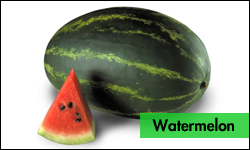Back to > Major Fruits | Minor Fruits | Underutilized Fruits
![]()
 |
|
|
Introduction:
Watermelons (Citrullis vulgaris) refer to both fruit and plant of a vine-like (climber and trailer) herb originally from southern Africa and one of the most common types of melon are a member of the cucurbit family, which also includes rock-melons, honeydew melons, cucumbers, pumpkins, squash, zucchini and other gourds. Common in fruit platters or as a refreshing desert at a picnic, watermelons are available in a wide range of sizes and shapes.
This flowering plant produces a special type of fruit known by botanists as a pepo, which has a thick rind (exocarp) and fleshy center (mesocarp and endocarp); pepos are derived from an inferior ovary and are characteristic of the Cucurbitaceae. The watermelon fruit, loosely considered a type of melon (although not in the genus Cucumis), has a smooth exterior rind (green, yellow and sometimes white) and a juicy, sweet, usually red, but sometimes orange, yellow, or pink interior flesh. Dark red fleshed, black seeded varieties are the most popular on the market place. Yellow fleshed (champagne) melons and small mini melons also find a ready market. “Seedless” melons, although more difficult to grow, have become popular in the market.
Reference:
- “An African Native of World Popularity.” Texas A&M University Aggie Horticulture website. Retrieved Jul. 17, 2005.
- Anioleka Seeds USA. “Yellow Crimson Watermelon”. http://www.vegetableseed.net/heirloom-vegetable-seeds/melon-seeds/watermelon-seeds/yellow.html. Retrieved on 2007-08-07.
- Baker Creek Heirloom Seeds. “Watermelon Heirloom Seeds”. http://rareseeds.com/seeds/Watermelon. Retrieved on 2008-07-15.
- Baker Creek Heirloom Seeds. “Carolina Cross Watermelon”. http://rareseeds.com/seeds/Watermelon/Carolina-Cross. Retrieved on 2008-07-15.
- (BBC) Square fruit stuns Japanese shoppers BBC News Friday, 15 June, 2001, 10:54 GMT 11:54 UK
- “Black Japanese watermelon sold at record price“. http://ap.google.com/article/ALeqM5jJBRT0pnOdQVMUzzkKC_cGHo7IdQD914F62O0. Retrieved on 2008-06-10.
- Blomberg, Marina (June 10, 2004). “In Season: Savory Summer Fruits.” The Gainesville Sun. Retrieved Jul. 17, 2005.
- “Charles Fredric Andrus: Watermelon Breeder.” Cucurbit Breeding Horticultural Science. Retrieved Jul. 17, 2005.
- Collins JK, Wu G, Perkins-Veazie P, Spears K, Claypool PL, Baker RA, Clevidence BA. (2007). Watermelon consumption increases arginine plasma concentrations in adults. Nutrition 23(3):261-6.
- “Cream of Saskatchewan Watermelon“. http://www.seedsavers.org/prodinfo.asp?number=778. Retrieved on 2007-04-23.
- “Crop Production: Icebox Watermelons.” Washington State University Vancouver Research and Extension Unit website. Retrieved Jul. 17, 2005.
- Daniel Zohary and Maria Hopf, Domestication of Plants in the Old World, third edition (Oxford: University Press, 2000), p. 193.
- Dayer, R.D. (1975). The Genera of Southern African floweringbplants Vol. 1. Dicotyledons, Department of Agricultural Technical Services. South Africa: Botanical Research Institute.
- Evans, Lynette (2005-07-15). “Moon & Stars watermelon (Citrullus lanatus):Seed-spittin’ melons makin’ a comeback”. http://sfgate.com/cgi-bin/article.cgi?file=/chronicle/archive/2005/07/16/HOG4UDNGDB1.DTL. Retrieved on 2007-07-06.
- Hamish, Robertson. “Citrullus lanatus (Watermelon, Tsamma).” Museums Online South Africa. Retrieved Mar. 15, 2005.
- H. Mandel, N. Levy, S. Izkovitch, S. H. Korman (2005). “Elevated plasma citrulline and arginine due to consumption of Citrullus vulgaris (watermelon)”. Berichte der deutschen chemischen Gesellschaft 28 (4): 467–472. doi:10.1007/s10545-005-0467-1.
- “The column of watermelon peel from 5hpk.com”.
- http://www.5hpk.com/Html/TOPIC/200807172.html. Retrieved on 2008-07-15.
- http://www.agriculture.gov.gy/Farmers%20Manual/PDF/Watermelon.pdf. Retrieved on 2009-07-30
- Jian L, Lee AH, Binns CW. Tea and lycopene protect against prostate cancer. Asia Pac J Clin Nutr. 2007;16 Suppl 1:453-7. 2007. PMID:17392149.
- Lucotti P, Setola E, Monti LD, Galluccio E, Costa S, Sandoli EP, Fermo I, Rabaiotti G,Gatti R, Piatti P. (2006). Beneficial effects of a long-term oral L-arginine treatment added to a hypocaloric diet and exercise training program in obese, insulin-resistant type 2 diabetic patients. Am J Physiol Endocrinol Metab:291(5):E906-12.
- Matos HR, Di Mascio P, Medeiros MH. Protective effect of lycopene on lipid peroxidation and oxidative DNA damage in cell culture. Arch Biochem Biophys 2000 Nov 1;383(1):56-9 2000.
- “Melitopolski Watermelon“. http://www.seedsavers.org/prodinfo.asp?number=267. Retrieved on 2007-04-23.
- “Moon and Stars Watermelon Heirloom“. http://rareseeds.com/seeds/Watermelon/Moon-and-Stars. Retrieved on 2008-07-15.
- “Moon and Stars Watermelon“. http://www.seedsavers.org/prodinfo.asp?number=266. Retrieved on 2007-04-23.
- Motes, J.E.; Damicone, John; Roberts, Warren; Duthie, Jim; Edelson, Jonathan. “Watermelon Production.” Oklahoma Cooperative Extension Service. Retrieved Jul. 17, 2005.
- Müller T, Ulrich M, Ongania KH, Kräutler B. (2007). Colorless tetrapyrrolic chlorophyll catabolites found in ripening fruit are effective antioxidants. Angew Chem Int Ed Engl. 2007;46(45):8699-702.
- National Research Council (2008-01-25). “Watermelon”. Lost Crops of Africa: Volume III: Fruits. Lost Crops of Africa. 3. National Academies Press. ISBN 978-0-309-10596-5. http://books.nap.edu/openbook.php?record_id=11879&page=165. Retrieved on 2008-07-17.
- “Oklahoma Declares Watermelon Its State Vegetable“. 2007-04-18. http://cbs4denver.com/watercooler/watercooler_story_108064706.html. Retrieved on 2007-07-20.
- “Orangeglo Watermelon“. http://www.seedsavers.org/prodinfo.asp?number=1108. Retrieved on 2007-04-23.
- Parsons, Jerry, Ph.D. (June 5, 2002). “Gardening Column: Watermelons.” Texas Cooperative Extension of the Texas A&M University System. Jul. 17, 2005.
- Salleh, H. (1986). Constrain and challenges in melon breeding in Peninsular Malaysia. Proc. Of the Plant and Animal Breeding Workshop, Serdang: MARDI
- Shosteck, Robert (1974). Flowers and Plants: An International Lexicon with Biographical Notes. Quadrangle/The New York Times Book Co.: New York.
- Southern U.S. Cuisine: Judy’s Pickled Watermelon Rind
- http://home.howstuffworks.com/watermelon3.htm
- Stone, B.C. (1970). The flora of Guam. Micronesic 6: 562.
- Vegetable Research & Extension Center – Icebox Watermelons”. http://agsyst.wsu.edu/Watermelon.html. Retrieved on 2008-08-02.
- Wada, M. (1930). “Über Citrullin, eine neue Aminosäure im Presssaft der 28. Wassermelone, Citrullus vulgaris Schrad.”. Biochem. Zeit. 224: 420.
- “Watermelon.” The George Mateljan Foundation for The World’s Healthiest Foods. Retrieved Jul. 28, 2005.
- “Watermelon History.” National Watermelon Promotion Board website. Retrieved Jul. 17, 2005.
